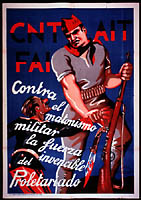 |
C.N.T., A.I.T., F.A.I.: Contra el matonismo militar, la fuerza invencible del Proletariado
[Against the military bullying, the invincible force of the Proletariat]. Signed: Muro.. Confederación Regional de Levante. Lit. García Cantos. Valencia Controlado, C.N.T. U.G.T. Lithograph, 6 colors; 100 x 70 cm.
|
|
In the first days of
the war, when less than thirty percent of the regular army remained
loyal to the government, popular militias were formed by the left-wing
political parties and unions in cities throughout Spain to defend
the Republic. This poster depicts an anarchist militiaman wresting
a bloodstained dagger-a symbol of treachery-from his diminutive
Nationalist opponent. The caricatured enemy wears an antiquated
uniform, a reflection of the old-fashioned system he represents.
In contrast, the anarchist militiaman wears no uniform save for
a red cap and bandanna, symbols of his solidarity with the revolutionary
cause.
Although the militias
fared well in streetfighting forays against the military rebels
at the beginning of the war, their lack of experience and discipline
placed them at a distinct disadvantage when they met Franco's troops
under normal combat conditions. For this reason, in September 1936,
the socialist prime minister Francisco Largo Caballero promulgated
measures providing for the militarization of the militias and the
creation of a Popular Army. While moderate anarchist leaders saw
the necessity of these measures, more radical libertarians regarded
any concessions to authoritarianism as a serious breech of the movement's
central tenets. Nevertheless, threatened with having their arms,
supplies and pay withheld by the central government, even the most
militant anarchist militias eventually capitulated. By June 1937,
all the Republican militias had been militarized or incorporated
into the Popular Army.
The three groups mentioned
in the caption, the CNT, AIT, and FAI, were all prominent organizations
within the anarchist movement. The CNT was the anarchist trade union;
the FAI was its political wing. AIT was the Anarchists' international
umbrella group. The red and black letters evoke the red and black
bands of the anarchist flag.
The poster was produced
in the first months of the war by a committee of two trade unions,
the anarchist CNT and the socialist UGT. These unions controlled
the production process in Valencia until the Republican government
transferred to the city in November 1936; thereafter the government's
agencies began gradually to take charge of the situation. The artist
who designed this poster, Muro, is not documented other than in
this instance.
|




